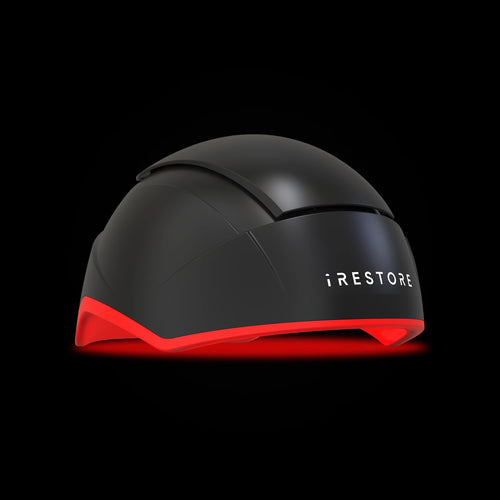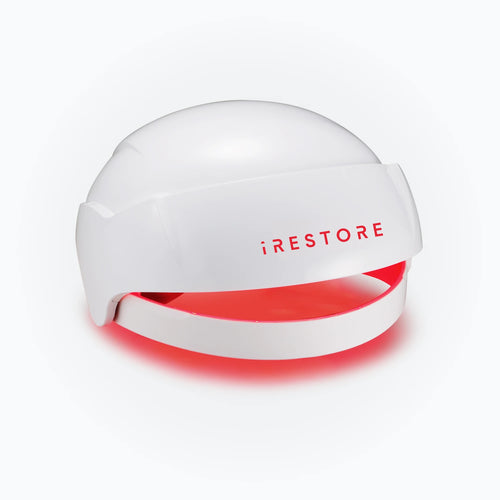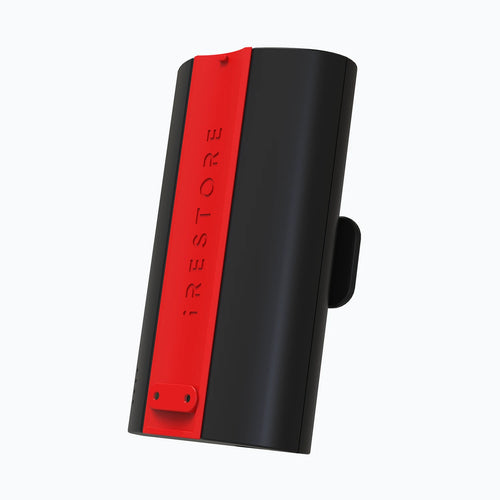Have you ever heard someone say that wearing a hat can make you go bald or cause a receding hairline? It’s a claim that’s been around for decades and still makes people question whether their favorite cap, beanie, or helmet might be doing more harm than good. The idea sounds simple enough but is there actually any truth to it?
Where the Hat Hair Loss Myth Comes From
The belief that hats cause baldness has been around for generations. Most of it comes down to how hats make hair look and how people interpret those changes. When hair is pressed flat under a cap or helmet, it can look thinner or less full once the hat comes off, a temporary effect often mistaken for the early signs of hair loss.
Another reason the myth stuck is the assumption that hair follicles need to “breathe.” Since hats cover the scalp, many people believe they suffocate hair or block circulation. In reality, follicles get their oxygen and nutrients from blood vessels beneath the skin, not from the air.
These misconceptions, combined with the fact that many men start experiencing hair loss around the same age they regularly wear hats, helped fuel the myth that hats are to blame.
What Actually Causes Hair Loss
While it’s easy to blame external factors like hats, true hair loss almost always starts beneath the surface of the scalp. The most common causes include:
-
Genetics (Pattern Baldness): Male and female pattern baldness is hereditary and linked to how hair follicles respond to hormones like DHT (dihydrotestosterone).
-
Hormonal Changes: Shifts due to aging, pregnancy, menopause, or thyroid issues can trigger thinning.
-
Medical Conditions: Autoimmune disorders such as alopecia areata, scalp infections, or chronic illness can contribute to shedding.
-
Lifestyle Factors: Poor nutrition, unmanaged stress, and smoking can damage hair over time, making it more fragile and prone to breakage.
-
Aging: As we grow older, follicles naturally produce thinner, shorter strands.
These underlying causes explain the vast majority of hair loss cases, not wearing hats, beanies, or helmets.
Do Hats Really Contribute to Hair Loss?
Most people can wear hats every day without worrying about baldness. Hats sit on top of your head and do not affect the way hair grows beneath the skin. Hair follicles get their nutrients from blood vessels in the scalp, not from the outside air.
There are only a few situations where hats might play a small role:
-
Very tight hats
When a hat is too snug, it can create constant pressure on the same areas of the scalp. Over time, this pressure may pull on the roots and stress the follicles, especially around the hairline. This repeated strain is called traction alopecia. It does not happen overnight, but long-term use of tight headwear can contribute to hair weakening and breakage in sensitive areas. Choosing hats that fit comfortably helps avoid this issue.
-
Dirty or sweaty hats
Hats absorb sweat, oil, and dead skin cells from the scalp. If a hat is not cleaned regularly, bacteria and fungus can build up inside the fabric. When worn for long periods, this buildup can irritate the scalp and cause itching, dandruff, or even mild infections. While irritation itself does not cause permanent baldness, it can lead to extra shedding or worsen existing thinning. Keeping hats clean and rotating them often prevents these problems.
-
Friction from daily wear
Hats that rub against the same spot can cause friction, especially if you have fine or fragile hair. Over time, this can make strands in that area weaker and more likely to break. Breakage is different from true hair loss because the follicle is still alive and able to grow new hair, but it can make hair look thinner temporarily. Choosing softer fabrics and making sure the hat is not rubbing harshly against your scalp helps protect the hair.
For the vast majority of people, hats are safe to wear every day. Dermatologists and hair specialists agree that genetics, hormones, and overall health are the real causes of baldness, not your choice of headwear (Mayo Clinic). If you are worried about early signs of thinning, it is more useful to look into proven solutions such as low-level laser therapy for hair growth.
The Difference Between Hat Hair and Hair Loss
Hat hair is a temporary change in appearance that happens when a hat presses down on your strands. The hair looks flat, limp, or a little oily after removing the hat, and the scalp may feel warm if you’ve been wearing it for a long time. This does not affect the follicle itself. Once you wash or restyle, your hair goes back to normal.
Hair loss, on the other hand, happens at the root level inside the scalp and can begin with noticeable hair shedding. It occurs when follicles shrink or stop producing healthy strands because of genetics, hormones, age, or health conditions. Unlike hat hair, true hair loss does not correct itself without treatment.
Here’s a quick comparison:
|
Aspect |
Hat Hair |
Hair Loss |
|
Cause |
Pressure from wearing a hat |
Genetics, hormones, aging, or medical conditions |
|
Appearance |
Flat, oily, or messy hair after removing a hat |
Thinning, widening part, receding hairline, or bald patches |
|
Duration |
Temporary, disappears with washing or restyling |
Progressive, continues without treatment |
|
Effect on Follicles |
No impact on follicle health |
Follicles shrink or stop producing hair |
|
Solution |
Restyle, wash, or let hair breathe |
Treatments such as laser therapy, medication, or lifestyle changes |
This makes it clear that hat hair is only a cosmetic issue, while hair loss is a biological process that needs proper attention.
How to Wear Hats Without Hair Loss Worries
If you enjoy wearing hats, there’s no reason to stop. With a few simple habits, you can make sure your headwear never gets in the way of healthy hair.
-
Pick the right fit
Choose hats that feel comfortable and not overly tight. A snug hat is fine, but if it leaves deep marks on your forehead or feels like it is pulling on your hair, it may be too small.
-
Keep hats clean
Wash or wipe the inside of your hats regularly. Sweat, oil, and dirt can build up in the fabric and irritate your scalp if the hat is worn too often without cleaning.
-
Go for breathable fabrics
Cotton or moisture-wicking materials allow better airflow and reduce sweat buildup. Heavy synthetic fabrics can trap heat and make the scalp feel itchy.
-
Avoid constant friction
If a hat rubs against the same spot every day, it can weaken fragile strands. Rotate different hats or adjust how you wear them to reduce repeated friction.
-
Take short breaks
Removing your hat when you’re indoors or at rest gives your scalp a chance to breathe and stay comfortable.
By following these simple steps, you can wear hats daily without worrying about thinning hair or scalp irritation.
Proven Ways to Protect and Regrow Hair
While hats are not to blame for thinning or baldness, there are proven ways to maintain healthy hair and encourage regrowth if you’ve started noticing changes.
-
Maintain scalp health
A clean, balanced scalp is essential for strong hair. Washing regularly, managing dandruff, and avoiding product buildup help create the right environment for growth.
-
Focus on nutrition
Hair needs vitamins, minerals, and protein to stay strong. A diet rich in iron, zinc, vitamin D, and biotin supports healthy follicles and reduces the risk of shedding.
-
Manage stress
High stress levels can trigger hair loss conditions like telogen effluvium. Relaxation techniques, exercise, or mindfulness practices can reduce stress-related shedding.
-
Consider medical treatments
FDA-approved solutions like minoxidil and finasteride can help slow or reverse hair loss for many people. A dermatologist can guide you on whether these treatments are right for you.
-
Use clinically proven technology
Low-level light therapy (LLLT) devices, such as the iRESTORE Laser Hair Growth System, are backed by clinical studies showing they can stimulate follicles and promote regrowth. Unlike myths about hats, this is real science that helps address hair loss at the root level.

By combining healthy habits with proven treatments, it’s possible to slow down thinning and even restore fuller, thicker hair.
Conclusion
Wearing hats does not cause baldness, receding hairlines, or permanent thinning. The real causes of hair loss are rooted in genetics, hormones, health conditions, and lifestyle factors. Myths about hats often come from the temporary flattening known as hat hair, which has nothing to do with long-term follicle health.
If you’re noticing changes in your hair, the best step is to focus on proven solutions that support growth and scalp health. Options like balanced nutrition, stress management, and advanced technologies such as light therapy can make a real difference.
Your favorite hat is not the enemy of your hair. With the right care, you can protect your scalp, support regrowth, and keep wearing hats with confidence.
FAQs
Can hats cause a receding hairline?
A hat that is extremely tight and worn every day may create tension on the hairline, which can contribute to traction alopecia over time. However, this is rare, and normal hat use will not cause a receding hairline.
Does sweating under a hat cause hair loss?
Sweat itself does not cause hair loss. The problem comes when hats are not cleaned regularly, which can trap sweat and bacteria against the scalp. This may lead to irritation but does not cause permanent baldness.
Can helmets or hard hats cause bald spots?
Helmets do not directly cause bald spots. If they fit too tightly or rub against the same spot every day, they may cause friction or breakage, but this is not true hair loss.
Disclaimer: The iRESTORE blog is for informational purposes only and is not intended to replace professional medical advice or treatment. Please do not ignore professional guidance because of information you’ve read here. If you have concerns about your hair or skin health, we encourage you to consult a qualified healthcare professional.



















